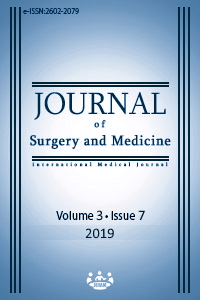Transaortic celiac plexus block: A computed tomography simulation study
Keywords:
Celiac plexus block, Computed tomography, Transaortic, Sympathetic ganglion blockAbstract
Aim: Transaortic celiac plexus block (CPB) is a traditional treatment method in chronic upper abdominal pain. Knowing the technique parameters before the procedure provides convenience to the physician during the block. For this purpose, we simulated the transaortic CPB with computed tomography (CT) and thus aimed to determine the main technical parameters and the risk of complications.
Methods: This study was an observational study. We analyzed one hundred, transaxial, thin section, abdominopelvic CT images and recorded morphological disturbances such as the presence of aortic mural calcification, thrombus, and aneurysm. We drew a needle insertion pathway on each of the images, at left, seven cm away from the midline in the lumbar region. Subsequently, we recorded the penetrated organs, the needle entry angle, and the distance from the skin to the needle tip. Also, we measured the appropriate entry distance and angle for successful injection in patients that we could not provide transaortic access.
Results: In the CT-simulated images, according to defined level and distance, we could reach the aorta in 73% of the patients. The mean needle entry angle and the distance from the entry point to the needle tip was 23.33 (3.36)°, 15.25 (1.20) cm, respectively, and kidney penetration was 6.9%. We were able to access aorta in remaining 27% of patients with a mean distance of needle entry point from the midline, a mean needle entry angle, and a mean distance from the entry point to the needle tip, 10.08 (1.25) cm, 34.04 (5.43)°, and 17.09 (1.32) cm, respectively. The kidney penetration rate was 44.4% in these patients.
Conclusion: In the transaortic technique used for the CPB, successful aortic penetration is not always achieved. When the access angle and distance are increased, aortic transition can be achieved, but the risk of organ injury significantly increases.
Downloads
References
Bahn BM, Erdek MA. Celiac plexus block and neurolysis for pancreatic cancer. Curr Pain Headache Rep. 2013;17(2):310.
Kappis M. Sensibilitat und lokale Anasthesie im chirurgischen Gebiet der Bauchhohle mit besonderer Berucksichtigung der splanchnicus-Aasthesie. Beitrage zur klinischen Chirurgie. 1919;115:161-75.
Eisenberg E, Carr DB, Chalmers TC. Neurolytic celiac plexus block for treatment of cancer pain: a meta-analysis. Anesth Analg. 1995;80(2):290-5.
Lieberman RP, Waldman SD. Celiac plexus neurolysis with the modified transaortic approach. Radiology. 1990;175(1):274-6.
Ischia S, Luzzani A, Ischia A, Faggion S. A new approach to the neurolytic block of the coeliac plexus: the transaortic technique. Pain. 1983;16(4):333-41.
Kim WH, Lee CJ, Sim WS, Shin BS, Ahn HJ, Lim HY. Anatomical analysis of computed tomography images for determining the optimal oblique fluoroscope angle for percutaneous coeliac plexus block. J Int Med Res. 2011;39(5):1798-807.
Moore DC, Bush WH, Burnett LL. Celiac plexus block: a roentgenographic, anatomic study of technique and spread of solution in patients and corpses. Anesth Analg. 1981;60(6):369-79.
Kong YG, Shin JW, Leem JG, Suh JH. Computed Tomography (CT) Simulated Fluoroscopy-Guided Transdiscal Approach in Transcrural Celiac Plexus Block. Korean J Pain. 2013; 26(4):396–5.
Garcia-Eroles X, Mayoral V, Montero A, Serra J, Porta J. Celiac plexus block: a new technique using the left lateral approach. Clin J Pain. 2007;23(7):635-7.
De Cicco M, Matovic M, Bortolussi R, Coran F, Fantin D, Fabiani F, et al. Celiac plexus block: injectate spread and pain relief in patients with regional anatomic distortions. Anesthesiology. 2001;94(4):561-65.
Pereira GA, Lopes PT, Dos Santos AM, Pozzobon A, Duarte RD, Cima Ada Set al. Celiac plexus block: an anatomical study and simulation using computed tomography. Radiol Bras. 2014;47(5):283-7.
Waldman, SD. Atlas of Interventional Pain Management, 2nd edition: SD. Waldman. Saunders, Elsevier: Philadelphia, USA, 2004.
Polati E, Luzzani A, Schweiger V, Finco G, Ischia S. The role of neurolytic celiac plexus block in the treatment of pancreatic cancer pain. Transplant Proc. 2008;40(4):1200-4.
Tewari S, Agarwal A, Dhiraaj S, Gautam SK, Khuba S, Madabushi R, et al. Comparative evaluation of retrocrural versus transaortic neurolytic celiac plexus block for pain relief in patients with upper abdominal malignancy: A retrospective observational study. Indian J Palliat Care. 2016;22(3):301-6.
Kambadakone A, Thabet A, Gervais DA, Mueller PR, Arellano RS. CT-guided Celiac Plexus Neurolysis: A Review of Anatomy, Indications, Technique, and Tips for Successful Treatment. RadioGraphics. 2011;31(6):1599-621.
Cornman-Homonoff J, Holzwanger D, Lee K, Madoff D, Li D. Celiac Plexus Block and Neurolysis in the Management of Chronic Upper Abdominal Pain. Semin intervent Radiol. 2017;34(04):376-86.
Weber JG, Brown DL, Stephens DH, Wong GY. Celiac plexus block. Retrocrural computed tomographic anatomy in patients with and without pancreatic cancer. Reg Anesth. 1996;21(5):407-13.
Abbas DN. Evaluation of Trans-Aortic Oblique Fluoroscopic Tunnel Vision Approach of Celiac Plexus Block after Failure of the Classic Approach. J Pain Relief. 2012;01(02):1-5.
Downloads
- 1830 2098
Published
Issue
Section
How to Cite
License
Copyright (c) 2019 Ender Sir, Sami Eksert
This work is licensed under a Creative Commons Attribution-NonCommercial-NoDerivatives 4.0 International License.
















